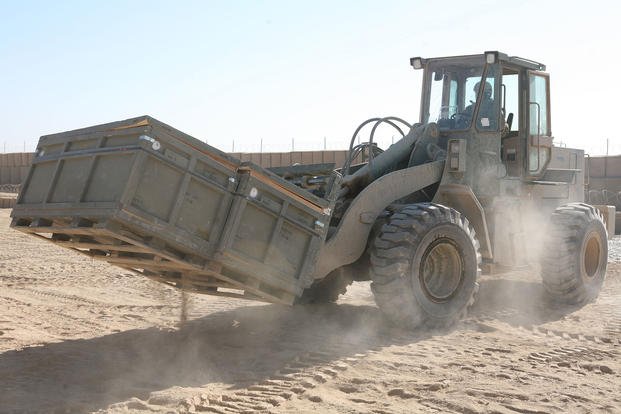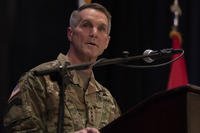Mission-critical logistics support is a never-ending battle for special operations forces (SOF) deployed to Afghanistan. This is especially true for the combined special operations task force (CSOTF) that operates in seven provinces of eastern Afghanistan and mentors Afghan National Security Forces.
Special operations by their very nature place small teams in remote, austere locations without the logistics structure that normally supports conventional forces -- often for protracted periods of time. An organic sustainment reach-back capability originally was designed and provided for as a part of the Army SOF transformation several years ago.
However, since so many SOF units have remained deployed to Afghanistan for such a variety of missions over such a large and diverse geographic area and have been doing so for so long, the support structure originally envisioned has had to be augmented. This has compelled many SOF units, such as the CSOTF, to create their own capabilities, internally or out of hide, especially for things such as logistics.
The Logistics Cell
Personnel with a variety of backgrounds comprise the logistics roster of the CSOTF. The C-4 (logistics officer), sailors, soldiers and contractors work together to deliver world-class logistics in eastern Afghanistan.
The task force also has a forward logistics element, or LOG cell, at Bagram Airfield (BAF) to help reduce response time to remote outstations to the east and north of Kabul and BAF. Originally, when the task force was composed almost entirely of one battalion of an Army SOF group, the task force -- with help from its theater special operations command -- developed the BAF LOG cell as a means of providing more responsive logistics support in this mature theater.
Most of the logistics support for the task force now originates from conventional forces, especially for things such as class I (subsistence), class III (petroleum, oils and lubricants) and class V (ammunition), but the LOG cell aids in the movement and distribution of these essential logistics elements.
Functional Areas
The BAF LOG cell has three functional areas: ammunition, movement and supply. The most important function of any unit's logistics element or support structure is its ability to arm the unit so that it can engage the enemy. The BAF LOG cell does this with the help of one ammunition specialist.
The next most important -- but possibly the most visible since most members of the task force arrive in Afghanistan by way of BAF -- is the movement control function.
In a conventional unit, such as a brigade combat team, the S-4 shop or Army logistics operations center will have a dedicated movements cell manned by a mobility warrant officer-in-charge and at least one military occupational specialty (MOS) 88N (transportation management coordinator) noncommissioned officer.
However, in the austere SOF environment, the primary movement control responsibilities are accomplished by a civilian contractor.
The supply function also receives a high degree of emphasis and visibility. The staff providing the expertise and effort to keep supplies flowing from BAF to the rest of the task force includes an Air Force staff sergeant, a Navy petty officer second class and an Army specialist who is an MOS 92Y (unit supply specialist).
Synchronization
Effective logistics support, especially for SOF, requires deliberate and meticulous planning to anticipate the needs of teams in the field and ensure mission success. This planning must be synchronized with all echelons of the task force, including the advanced operations base (AOB), which is essentially a company headquarters from the SOF battalion.
When a supply request is submitted directly to the BAF LOG cell and has not gone through the AOB, which has its own supply sergeant, the AOB has no visibility of the transaction. The BAF LOG cell has to backtrack and ensure that the AOB has visibility so that the logistics common operational picture is accurate.
Equipment
Certain pieces of equipment are essential for LOG cell operations. One of the cell's most important pieces of equipment is the 10,000-pound capacity forklift. The task force's five-ton medium tactical vehicle with trailer and 11-ton load-handling system also help increase the task force's logistics throughput capability.
New technologies have made the never-ending logistics battle much more manageable for the BAF LOG cell. Using in-transit visibility and frequently checking the strategic management system for real-time movement changes -- particularly passenger movements -- are incredibly helpful for managing logistics operations.
The multitasking soldiers, sailors and airmen of the BAF LOG cell have been outstanding combat multipliers for the entire task force. From the upper reaches of Kapisa Province all the way down to Paktia, they have kept the SOF units fully operational.
The task force has sustained operations in a versatile, flexible and responsive manner to ensure the units and their partners are ready and can find, fix and finish any threat by providing a fully integrated and synchronized SOF-unique logistics foundation.
As we prepare to transition to whatever lies ahead here, let us not forget the hard-won logistics lessons of recent special operations. SOF logisticians must adhere firmly to proper planning, forecasting and requisition procedures, truly understand the lessons of the not-so-distant past and forge on to even greater successes in future operations.
Want to Know More About the Military?
Be sure to get the latest news about the U.S. military, as well as critical info about how to join and all the benefits of service. Subscribe to Military.com and receive customized updates delivered straight to your inbox.







